Three Years with the Porsche 981 Boxster GTS: Inspection Costs and Ownership Impressions
公開日:2018.11.04
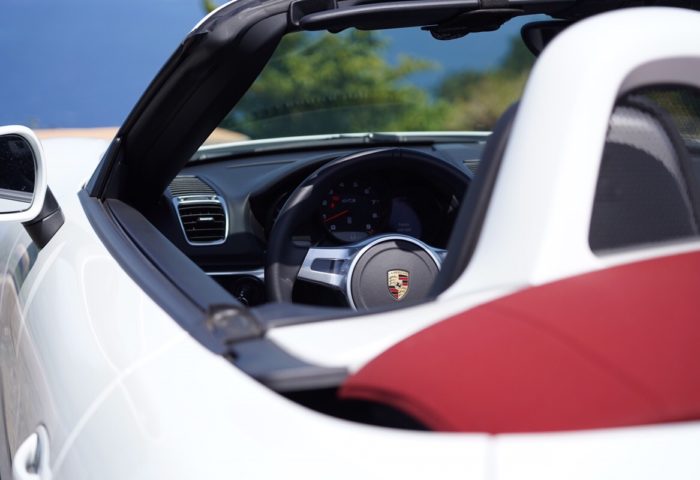
Three Years Since Buying the Boxster
It’s been almost three years since my husband purchased the 981 Boxster GTS. Time flies… So, I decided to summarize the general details of the dealer inspection and my husband’s review of the Boxster after three years.
The current mileage is 30,600 km (he hasn’t gone on many tours with the Boxster in the past year). There were no major issues during the inspection, and the Boxster returned home in about a week. The inspection details are roughly as follows:
① Extended warranty application for 1 year… 100,440 yen
→ I previously wrote an article titled “Should You Get Porsche Approved Warranty After 3 Years of New Boxster Ownership?”, and in the end, we applied.
② Inspection… 213,074 yen
・Headlight focus adjustment
・Rear brake caliper bolt replacement
・Engine oil change (Mobil1 5W-50) 7.5L
・Oil filter replacement
・Brake fluid replacement
・Air conditioning filter replacement
・Left and right air cleaner filter replacement
・Navigation system version upgrade (final free update)
・Battery charging (free service)
③ Taxes… 51,630 yen
・Automobile weight tax for 2 years… 24,600 yen
・Compulsory insurance for 24 months… 25,830 yen
So, the total cost for this inspection was 365,144 yen. It feels expensive to pay over 200,000 yen for an inspection when nothing is broken… (;゚Д゚) (My husband said he just goes along with whatever the dealer recommends, so it might be possible to get it cheaper.)
By the way, here’s the status of the tires and brake pads. The rear tires were replaced once due to a puncture, but the front tires are still the original ones from new. Despite multiple visits to circuits and driving schools, my husband says the tires have held up remarkably well.
Brake pad remaining thickness F: 6.5mm R: 8.0mm
Tire tread remaining F: 3.0mm R: 5.0mm
Husband’s Three-Year Overall Review
Next, here is my husband’s overall review after owning the Boxster for three years. He kindly wrote this summary himself, so I’ll share it just as he wrote it.
① Steering & Suspension
When I first drove it, I didn’t think the ride was uncomfortable, but on the highway, I distinctly felt a roughness and slight vibration in the steering wheel. This was more noticeable than when I drove my previous R171 SLK350. At an inspection, I had the wheel balance checked just in case, but there was no problem.
One day, I had the chance to ride in a friend’s Cayman GTS on the same route, and I felt exactly the same sensation in the steering wheel as in the Boxster. So, I realized this wasn’t a defect but just “how it is.”
Now it doesn’t bother me at all, but at first, I think I was overwhelmed by the amount of feedback the Porsche steering transmits.
② Ride Comfort
Most passengers say “the ride is very smooth” and “comfortable,” so I don’t think the ride is bad. However, when I first got the car, I did feel a certain “stiffness” in the suspension.
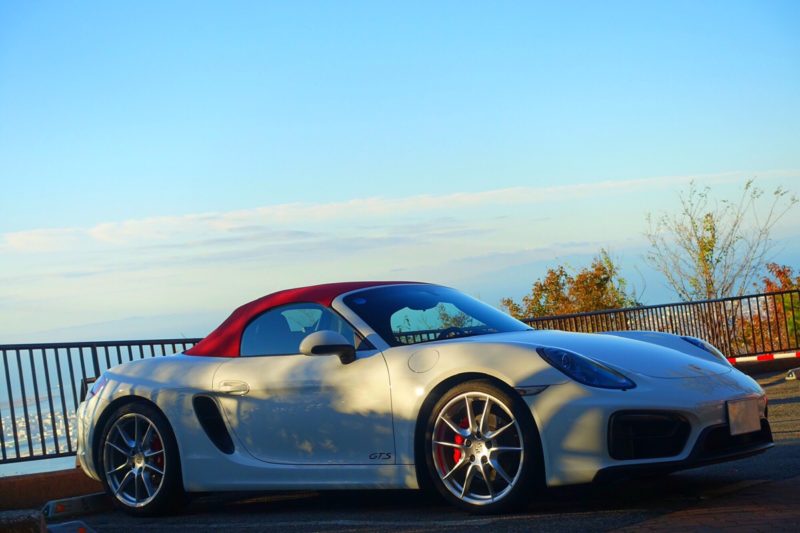
However, this “suspension stiffness” mostly disappeared after about 10,000 km, and now it’s very supple. I felt the same with the Panamera, so I think Porsche suspensions just take some time to break in.
Also, the ride feels better with a fuller gas tank. When the tank is low, the front becomes lighter, making the ride a bit bouncier, so I try to refuel often.
③ Convertible Top
The convertible top is very well made. Before seeing it in person, I thought it was
Opening and closing is fully automatic with a single switch, and can be done while driving up to about 50-60 km/h. It takes only about 9 seconds, so you can quickly respond to sudden rain.
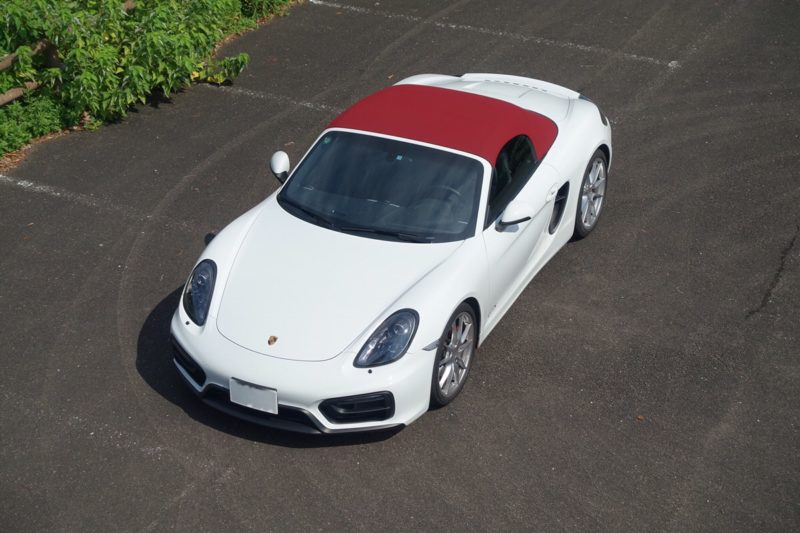
As for maintenance, just brushing off dirt and dust with a pig hair brush is enough. For heavy dirt, gently wash with a mild detergent foam. The dealer advised “You don’t need to wash it every time you wash the car, but if bird droppings land on it, remove them immediately as they become hard to clean later.”
④ Tires
My tires were Goodyear EAGLE F1 ASYMMETRIC 2 from new. Personally, I prefer Michelin, so I wasn’t expecting much from Goodyear since it was my first time using them, but they turned out to be excellent tires.
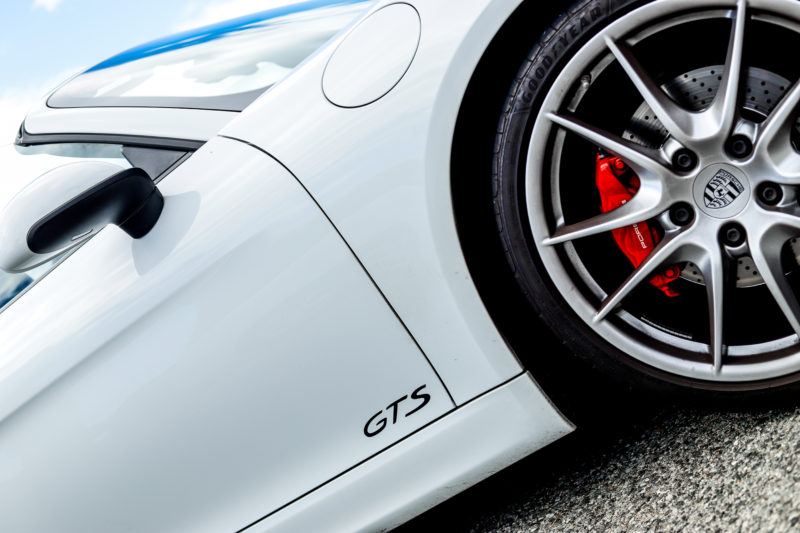
They have excellent roundness, wear resistance, quietness, and ride comfort. Most notably, their wet grip performance is outstanding. At Porsche’s driving school, there’s a lesson where you deliberately slide the car on a wet track, but these tires grip much better than expected. While other cars slide normally at the same speed, these tires kept gripping, making it hard to slide smoothly.
Also, they provide great grip on wet winding roads and general roads, giving a strong sense of security. Their wet water drainage is also sufficient, so you can drive confidently on rainy highways.
⑤ Engine
The engine’s responsiveness was great from delivery, but compared to other cars, I expected it to be sharper than it actually was. Specifically, I felt the high-rev range lacked a bit of punch.
When I brought it in for inspection, the service advisor told me:
“Porsche engines really start to come alive around 15,000 km.”
After that, around 20,000 km my car started to change noticeably, and by 25,000 km it was revving explosively. The mid-to-high rev range and the engine’s musical sound are very satisfying.
Regarding power and torque, I initially wondered “Can I handle this much?” but now I feel it’s
With the Panamera Turbo’s 550 PS, it’s clearly overwhelming and hard to fully exploit in Japan. But the Boxster GTS’s 330 PS is still manageable. If anything, I’d even prefer a bit less power. I think the basic, naturally aspirated Boxster is just right for driving freely in Japan.
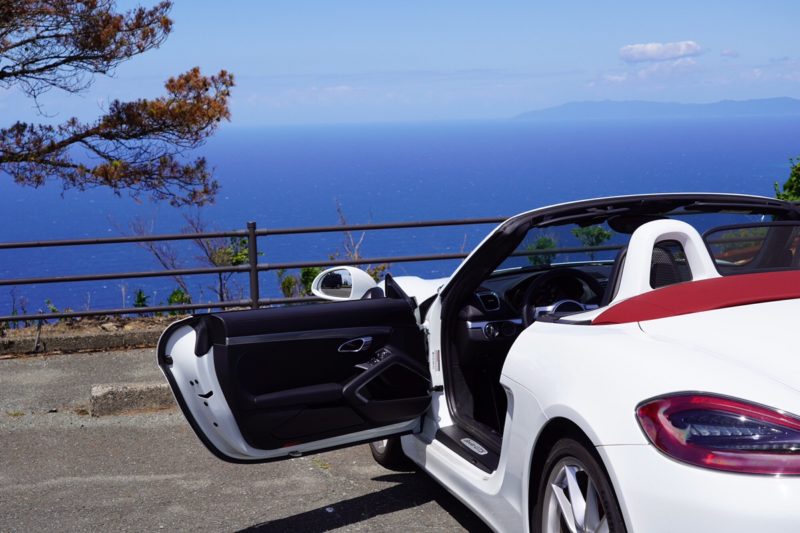
⑥ Quietness
It’s an open sports car, so it’s not silent, but with the top closed and the sport exhaust off, cruising is very comfortable. You can enjoy music or radio, and unlike old supercars, conversation with the passenger isn’t difficult.
However, when switched to Sport or Sport Plus and you press the accelerator deeply, the volume rises significantly. But it’s not an unbearable roar; it’s a refined yet powerful exhaust note (though this depends on personal taste).
⑦ Winding Roads
The Boxster is a car made for winding roads. It turns around its center like drawing circles with a compass, especially in tight corners. It’s not a fluttery lightness but a precise, continuous arc.
I once drove with a passenger who usually drives FR sports cars, and they were amazed at “how different the posture and G-forces feel during cornering.”
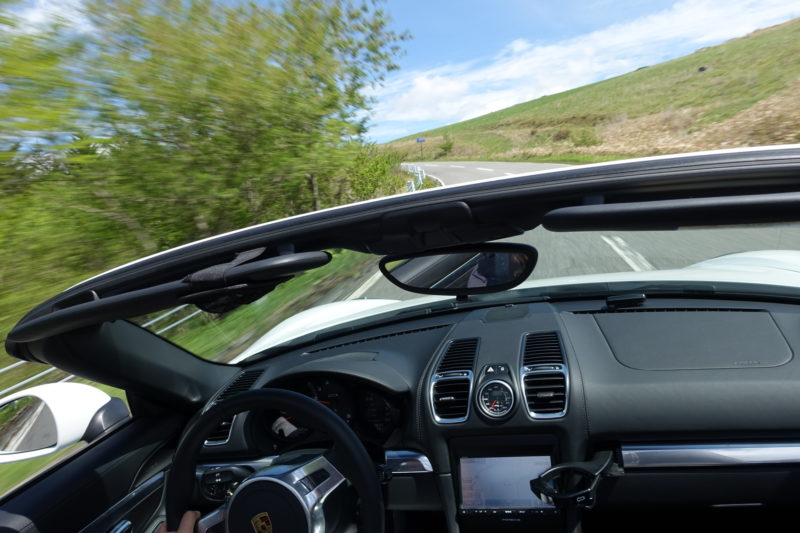
⑧ Brakes
Porsche brakes need no introduction. They used to squeal when new but stopped after the break-in. Besides being very effective, Porsche brakes are known for their excellent controllability. They respond to pedal pressure with a firm feel and don’t have deep travel. You can control them precisely from low to high speeds. Braking is even enjoyable with a Porsche.
⑨ Rigidity
Many worry about rigidity in a convertible. According to my data, the 981 Cayman’s torsional rigidity is 40,000 Nm/degree, while the Boxster’s is 17,000 Nm/degree. That sounds concerning, but there’s no need to worry.
On highways and winding roads, I don’t feel any lack of rigidity. Of course, on rough roads with the top closed, you might hear slight rubbing noises between the roof and body, but that’s about it. Sometimes when pushing hard through Fuji Speedway’s 100R corner, I feel a bit uneasy, but that’s the only time I’ve noticed it in Japan.
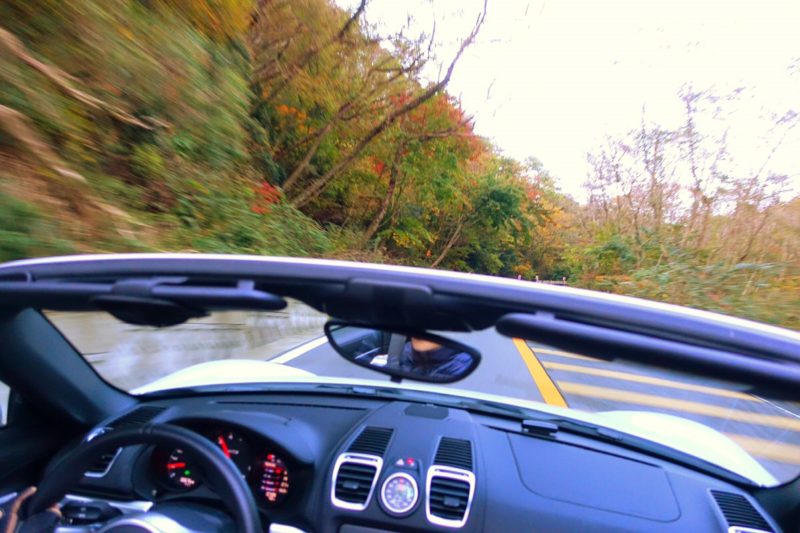
⑩ Highway Driving
There’s no sense of insecurity on the highway. Normal mode is fine, but switching the chassis to Sport makes the car move like a swimming fish—agile and confident. Lane changes, acceleration, and braking respond exactly as you want, with great peace of mind. However, for grand touring, the 911 might be better. It’s not tiring, but the 911 feels more stable.
At speeds over 200 km/h on Fuji Speedway’s straight, I sometimes feel a slight lack of downforce, so it’s not ideal for ultra-high-speed cruising. (Compared to the Panamera; it’s still much better than regular cars.) But unless you’re blasting down the Autobahn’s fast lane, it’s no concern in Japan. No worries here.
⑪ Everyday Usability
This car has the standard GTS PASM suspension, not the sports chassis. I’ve never scraped the car on bumps at convenience stores or gas stations in my usual area, so don’t worry about the low ride height.
One caution: when parking in reverse, if the parking block is high, you might scrape the lower rear bumper, so be careful. I usually stop with a little space before the block without touching the tires.
With a width of about 1800 mm, it fits in most mechanical parking garages and can be parked in coin lots without issue. Narrow roads and passing other cars aren’t a big problem at this size.
Also, as I introduced in a previous blog post about cargo capacity, it’s probably one of the most practical open two-seaters for carrying luggage.
That’s my husband’s overall review. “I could write a more detailed review if asked, but I’ll leave it here for now,” he said (laughs). Reading this makes me want to get better at driving the Boxster… Next weekend, my mother-in-law is coming over, so I’m definitely going to practice driving the Boxster’s manual transmission then!
このブログが気に入ったらフォローしてね!


Comment ( 0 )
Trackbacks are closed.
No comments yet.